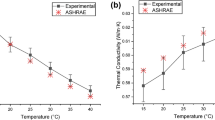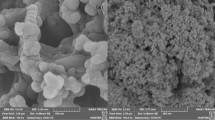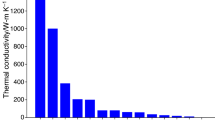Abstract
Recently, the suspension of hybrid nanoparticles in conventional fluids has been investigated as a technique for improving the thermophysical properties of nanofluids. The dearth of documentation on the trio influence of volume concentration, base fluid, and temperature on the electrical conductivity and viscosity of hybrid alumina–ferrofluids [Al2O3–Fe2O3 (25:75 mass%)] has led to this study. The effective viscosity and electrical conductivity of the deionized water (DW)-based and ethylene glycol (EG)–DW-based (50:50 vol%) hybrid alumina–ferrofluids were measured at temperatures of 20–50 °C and volume concentrations of 0.05–0.75%. Based on the importance of soft computing methods to engineers, adaptive neuro-fuzzy inference system (ANFIS) and artificial neural network (ANN) were used for predicting the relative viscosity and electrical conductivity of the two types of hybrid ferrofluids. The measured data for viscosity and electrical conductivity were used in the modeling. Model performances were evaluated using the root mean squared error index. Viscosity was enhanced by 3.23–43.64% and 2.79–49.38%, while electrical conductivity was increased by 163.37–1692.16% and 717.14–7618.89% for the DW- and EG–DIW-based hybrid ferrofluids, respectively, compared with the respective base fluids. Increasing volume concentration augmented the viscosity and electrical conductivity of all the hybrid alumina–ferrofluids, whereas a rise in temperature enhanced their electrical conductivity and detracted the viscosity. DW-based hybrid alumina–ferrofluid was observed to have a lower viscosity and higher electrical conductivity than the EG–DW-based counterpart. The results showed that the optimum ANN and ANFIS models have a maximum error of less than 4.5% and 3.9% for relative viscosity and electrical conductivity, respectively, which were lower than those proposed using regression analysis. With the hybrid alumina–ferrofluids possessing a lower viscosity relative to single-particle ferrofluids, they are recommended for engineering application.



















Similar content being viewed by others
References
Keblinski P, Prasher R, Eapen J. Thermal conductance of nanofluids: Is the controversy over? J Nanoparticle Res. 2008;10:1089–97. https://doi.org/10.1007/s11051-007-9352-1.
Xuan Y, Li Q. Heat transfer enhancement of nanofluids. Int J Heat Fluid Flow. 2000;21:58–64. https://doi.org/10.1016/S0142-727X(99)00067-3.
Masuda H, Ebata A, Teramae K, Hishinuma N. Alteration of thermal conductivity and viscosity of liquid by dispersing ultra-fine particles. Netsu Bussei. 1993;7:227–33. https://doi.org/10.2963/jjtp.7.227.
Choi SUS, Eastman JA. Enhancing thermal conductivity of fluids with nanoparticles. ASME Int Mech Eng Congr Expo. 1995;66:99–105. https://doi.org/10.1115/1.1532008.
Eastman JA, Choi SUS, Li S, Yu W, Thompson LJ. Anomalously increased effective thermal conductivities of ethylene glycol-based nanofluids containing copper nanoparticles. Appl Phys Lett. 2001;78:718–20. https://doi.org/10.1063/1.1341218.
Lee S, Choi SU-S, Li S, Eastman JA. Measuring thermal conductivity of fluids containing oxide nanoparticles. J Heat Transf. 1999;121:280. https://doi.org/10.1115/1.2825978.
Li Q, Xuan Y, Wang J. Experimental investigations on transport properties of magnetic fluids. Exp Therm Fluid Sci. 2005;30:109–16. https://doi.org/10.1016/j.expthermflusci.2005.03.021.
Jana S, Salehi-Khojin A, Zhong WH. Enhancement of fluid thermal conductivity by the addition of single and hybrid nano-additives. Thermochim Acta. 2007;462:45–55. https://doi.org/10.1016/j.tca.2007.06.009.
Jha N, Ramaprabhu S. Synthesis and thermal conductivity of copper nanoparticle decorated multiwalled carbon nanotubes based nanofluids. J Phys Chem C. 2008;112:9315–9. https://doi.org/10.1021/jp8017309.
Suresh S, Venkitaraj KP, Selvakumar P, Chandrasekar M. Synthesis of Al2O3–Cu/water hybrid nanofluids using two step method and its thermo physical properties. Coll Surf A Physicochem Eng Asp. 2011;388:41–8. https://doi.org/10.1016/j.colsurfa.2011.08.005.
Abbasi SM, Rashidi A, Nemati A, Arzani K. The effect of functionalisation method on the stability and the thermal conductivity of nanofluid hybrids of carbon nanotubes/gamma alumina. Ceram Int. 2013;39:3885–91. https://doi.org/10.1016/j.ceramint.2012.10.232.
Harandi SS, Karimipour A, Afrand M, Akbari M, D’Orazio A. An experimental study on thermal conductivity of F-MWCNTs-Fe3O4/EG hybrid nanofluid: effects of temperature and concentration. Int Commun Heat Mass Transf. 2016;76:171–7. https://doi.org/10.1016/j.icheatmasstransfer.2016.05.029.
Nadooshan AA, Eshgarf H, Afrand M. Measuring the viscosity of Fe3O4-MWCNTs/EG hybrid nanofluid for evaluation of thermal efficiency: Newtonian and non-Newtonian behavior. J Mol Liq. 2018;253:169–77. https://doi.org/10.1016/j.molliq.2018.01.012.
Afrand M, Toghraie D, Ruhani B. Effects of temperature and nanoparticles concentration on rheological behavior of Fe3O4–Ag/EG hybrid nanofluid: an experimental study. Exp Therm Fluid Sci. 2016;77:38–44. https://doi.org/10.1016/j.expthermflusci.2016.04.007.
Bahrami M, Akbari M, Karimipour A, Afrand M. An experimental study on rheological behavior of hybrid nanofluids made of iron and copper oxide in a binary mixture of water and ethylene glycol: non-Newtonian behavior. Exp Therm Fluid Sci. 2016;79:231–7. https://doi.org/10.1016/j.expthermflusci.2016.07.015.
Chen LF, Cheng M, Yang DJ, Yang L. Enhanced thermal conductivity of nanofluid by synergistic effect of multi-walled carbon nanotubes and Fe2O3 nanoparticles. Appl Mech Mater. 2014;548–549:118–23. https://doi.org/10.4028/www.scientific.net/AMM.548-549.118.
Sundar LS, Singh MK, Sousa ACM. Enhanced heat transfer and friction factor of MWCNT-Fe3O4/water hybrid nanofluids. Int Commun Heat Mass Transf. 2014;52:73–83. https://doi.org/10.1016/j.icheatmasstransfer.2014.01.012.
Parsian A, Akbari M. New experimental correlation for the thermal conductivity of ethylene glycol containing Al2O3–Cu hybrid nanoparticles. J Therm Anal Calorim. 2018;131:1605–13. https://doi.org/10.1007/s10973-017-6694-5.
Ebrahimi S, Saghravani SF. Experimental study of the thermal conductivity features of the water based Fe3O4/CuO nanofluid. Heat Mass Transf. 2018;54:999–1008. https://doi.org/10.1016/j.jmmm.2017.05.090.
Moldoveanu GM, Minea AA, Huminic G, Huminic A. Al2O3/TiO2 hybrid nanofluids thermal conductivity: an experimental approach. J Therm Anal Calorim. 2019;137:583–92. https://doi.org/10.1007/s10973-018-7974-4.
Gangadevi R, Vinayagam BK. Experimental determination of thermal conductivity and viscosity of different nanofluids and its effect on a hybrid solar collector. J Therm Anal Calorim. 2019;136:199–209. https://doi.org/10.1007/s10973-018-7840-4.
Goodarzi M, Toghraie D, Reiszadeh M, Afrand M. Experimental evaluation of dynamic viscosity of ZnO–MWCNTs/engine oil hybrid nanolubricant based on changes in temperature and concentration. J Therm Anal Calorim. 2019;136:513–25. https://doi.org/10.1007/s10973-018-7707-8.
Mousavi SM, Esmaeilzadeh F, Wang XP. Effects of temperature and particles volume concentration on the thermophysical properties and the rheological behavior of CuO/MgO/TiO2 aqueous ternary hybrid nanofluid Experimental investigation. J Therm Anal Calorim. 2019. https://doi.org/10.1007/s10973-019-08006-0.
Sedeh RN, Abdollahi A, Karimipour A. Experimental investigation toward obtaining nanoparticles’ surficial interaction with base fluid components based on measuring thermal conductivity of nano fluids. 2019;103:72–82. https://doi.org/10.1016/j.icheatmasstransfer.2019.02.016.
Dehghani Y, Abdollahi A, Karimipour A. Experimental investigation toward obtaining a new correlation for viscosity of WO3 and Al2O3 nanoparticles-loaded nanofluid within aqueous and non-aqueous basefluids problem of water consumption and waste production. J Therm Anal Calorim. 2019;135:713–28. https://doi.org/10.1007/s10973-018-7394-5.
Sulgani MT, Karimipour A. Improve the thermal conductivity of 10w40-engine oil at various temperature by addition of Al2O3/Fe2O3 nanoparticles. J Mol Liq. 2019;283:660–6. https://doi.org/10.1016/j.molliq.2019.03.140.
Ghasemi S, Karimipour A. Experimental investigation of the effects of temperature and mass fraction on the dynamic viscosity of CuO-paraffin nanofluid. Appl Therm Eng. 2018;128:189–97. https://doi.org/10.1016/j.applthermaleng.2017.09.021.
Kamalgharibi M, Hormozi F, Zamzamian SAH, Sarafraz MM. Experimental studies on the stability of CuO nanoparticles dispersed in different base fluids: influence of stirring, sonication and surface active agents. Heat Mass Transf Und Stoffuebertragung. 2016;52:55–62. https://doi.org/10.1007/s00231-015-1618-z.
Zendehboudi A, Saidur R, Mahbubul IM, Hosseini SH. Data-driven methods for estimating the effective thermal conductivity of nanofluids: a comprehensive review. Int J Heat Mass Transf. 2019;131:1211–31. https://doi.org/10.1016/j.ijheatmasstransfer.2018.11.053.
Adio SA, Mehrabi M, Sharifpur M, Meyer JP. Experimental investigation and model development for effective viscosity of MgO-ethylene glycol nanofluids by using dimensional analysis, FCM-ANFIS and GA-PNN techniques. Int Commun Heat Mass Transf. 2016;72:71–83. https://doi.org/10.1016/j.icheatmasstransfer.2016.01.005.
Sharifpur M, Adio SA, Meyer JP. Experimental investigation and model development for effective viscosity of Al2O3-glycerol nanofluids by using dimensional analysis and GMDH-NN methods. Int Commun Heat Mass Transf. 2015;68:208–19. https://doi.org/10.1016/j.icheatmasstransfer.2015.09.002.
Afrand M, Najafabadi KN, Sina N, Safaei MR, Kherbeet AS, Wongwises S, Dahari M. Prediction of dynamic viscosity of a hybrid nano-lubricant by an optimal artificial neural network. Int Commun Heat Mass Transf. 2016;76:209–14. https://doi.org/10.1016/j.icheatmasstransfer.2016.05.023.
Esfe MH, Firouzi M, Rostamian H, Afrand M. Prediction and optimization of thermophysical properties of stabilized Al2O3/antifreeze nanofluids using response surface methodology. J Mol Liq. 2018;261:14–20. https://doi.org/10.1016/j.molliq.2018.03.063.
Esfe MH, Arani AA. An experimental determination and accurate prediction of dynamic viscosity of MWCNT(40%)–SiO2(60%)/5W50 nano-lubricant. J Mol Liq. 2018;259:227–37. https://doi.org/10.1016/j.molliq.2018.02.095.
Ghaffarkhah A, Bazzi A, Dijvejin ZA, Talebkeikhah M, Moraveji MK, Agin F. Experimental and numerical analysis of rheological characterization of hybrid nano-lubricants containing COOH-Functionalized MWCNTs and oxide nanoparticles. Int Commun Heat Mass Transf. 2019;101:103–15. https://doi.org/10.1016/j.icheatmasstransfer.2019.01.003.
Alirezaie A, Saedodin S, Esfe MH, Rostamian SH. Investigation of rheological behavior of MWCNT (COOH-functionalized)/MgO—engine oil hybrid nanofluids and modelling the results with artificial neural networks. J Mol Liq. 2017;241:173–81. https://doi.org/10.1016/j.molliq.2017.05.121.
Esfe MH, Alirezaie A, Rejvani M. An applicable study on the thermal conductivity of SWCNT-MgO hybrid nanofluid and price-performance analysis for energy management. Appl Therm Eng. 2017;111:1202–10. https://doi.org/10.1016/j.applthermaleng.2016.09.091.
Esfe MH, Yan WM, Akbari M, Karimipour A, Hassani M. Experimental study on thermal conductivity of DWCNT-ZnO/water-EG nanofluids. Int Commun Heat Mass Transf. 2015;68:248–51. https://doi.org/10.1016/j.icheatmasstransfer.2015.09.001.
Akilu S, Baheta AT, Mior MA, Minea AA, Sharma KV. Properties of glycerol and ethylene glycol mixture based SiO2–CuO/C hybrid nanofluid for enhanced solar energy transport. Sol Energy Mater Sol Cells. 2018;179:118–28. https://doi.org/10.1016/j.solmat.2017.10.027.
Popiel CO, Wojtkowiak J. Simple formulas for thermophysical properties of liquid water for heat transfer calculations (from 0 °C to 150 °C). Heat Transf Eng. 1998;19:87–101. https://doi.org/10.1080/01457639808939929.
Prasher R, Song D, Wang J, Phelan P. Measurements of nanofluid viscosity and its implications for thermal applications. Appl Phys Lett. 2006;89:1–4. https://doi.org/10.1063/1.2356113.
Ijam A, Golsheikh AM, Saidur R, Ganesan P. A glycerol-water-based nanofluid containing graphene oxide nanosheets. J Mater Sci. 2014;49:5934–44. https://doi.org/10.1007/s10853-014-8312-2.
Sharker KK, Islam MN, Das S. Counterion effect on Krafft temperature and related properties of octadecyltrimethylammonium bromide. J Surfactants Deterg. 2017;20:923–32. https://doi.org/10.1007/s11743-017-1957-5.
Topallar H, Karadag B. Mechanism of micelle formation in sodium dodecyl sulfate and cetyltrimethylammonium bromide. J Surfactants Deterg. 1998;1:49–51. https://doi.org/10.1007/s11743-998-0007-5.
Hadadian M, Goharshadi EK, Youssefi A. Electrical conductivity, thermal conductivity, and rheological properties of graphene oxide-based nanofluids. J Nanoparticle Res. 2014;16:1–17. https://doi.org/10.1007/s11051-014-2788-1.
Zawawi NNM, Azmi WH, Redhwan AAM, Sharif MZ, Samykano M. Experimental investigation on thermo-physical properties of metal oxide composite nanolubricants. Int J Refrig. 2018;89:11–21. https://doi.org/10.1016/j.ijrefrig.2018.01.015.
Adio SA, Sharifpur M, Meyer JP. Investigation into effective viscosity, electrical conductivity, and pH of γ-Al2O3-glycerol nanofluids in Einstein concentration regime. Heat Transf Eng. 2015;36:1241–51. https://doi.org/10.1080/01457632.2015.994971.
Dardan E, Afrand M, Meghdadi Isfahani AH. Effect of suspending hybrid nano-additives on rheological behavior of engine oil and pumping power. Appl Therm Eng. 2016;109:524–34. https://doi.org/10.1016/j.applthermaleng.2016.08.103.
Esfe MH, Sarlak MR. Experimental investigation of switchable behavior of CuO-MWCNT (85%–15%)/10 W-40 hybrid nano-lubricants for applications in internal combustion engines. J Mol Liq. 2017;242:326–35. https://doi.org/10.1016/j.molliq.2017.06.075.
Zawrah MF, Khattab RM, Girgis LG, El Daidamony H, Abdel Aziz RE. Stability and electrical conductivity of water-base Al2O3 nanofluids for different applications. HBRC J. 2016;12:227–34. https://doi.org/10.1016/j.hbrcj.2014.12.001.
Guo Y, Zhang T, Zhang D, Wang Q. Experimental investigation of thermal and electrical conductivity of silicon oxide nanofluids in ethylene glycol/water mixture. Int J Heat Mass Transf. 2018;117:280–6. https://doi.org/10.1016/j.ijheatmasstransfer.2017.09.091.
Baby TT, Ramaprabhu S. Investigation of thermal and electrical conductivity of graphene based nanofluids. J Appl Phys. doi. 2010;10(1063/1):3516289.
Jamilpanah P, Pahlavanzadeh H, Kheradmand A. Thermal conductivity, viscosity, and electrical conductivity of iron oxide with a cloud fractal structure. Heat Mass Transf. 2017;53:1343–54. https://doi.org/10.1007/s00231-016-1891-5.
Mehrali M, Sadeghinezhad E, Rashidi MM, Akhiani AR, Latibari ST, Mehrali M, Metselaar HSC. Experimental and numerical investigation of the effective electrical conductivity of nitrogen-doped graphene nanofluids. J Nanoparticle Res. 2015;17:1–17. https://doi.org/10.1007/s11051-015-3062-x.
Kumar PG, Kumaresan V, Velraj R. Stability, viscosity, thermal conductivity, and electrical conductivity enhancement of multi-walled carbon nanotube nanofluid using gum arabic. Fullerenes Nanotub Carbon Nanostruct. 2017;25:230–40. https://doi.org/10.1080/1536383X.2017.1283615.
Naddaf A, Heris SZ. Experimental study on thermal conductivity and electrical conductivity of diesel oil-based nanofluids of graphene nanoplatelets and carbon nanotubes. Int Commun Heat Mass Transf. 2018;95:116–22. https://doi.org/10.1016/j.icheatmasstransfer.2018.05.004.
Baby TT, Sundara R. Synthesis and transport properties of metal oxide decorated graphene dispersed nanofluids. J Phys Chem C. 2011;115:8527–33. https://doi.org/10.1021/jp200273g.
Shen LP, Wang H, Dong M, Ma ZC, Wang HB. Solvothermal synthesis and electrical conductivity model for the zinc oxide-insulated oil nanofluid. Phys Lett Sect A Gen At Solid State Phys. 2012;376:1053–7. https://doi.org/10.1016/j.physleta.2012.02.006.
Adio SA, Sharifpur M, Meyer JP. Factors affecting the pH and electrical conductivity of MgO-ethylene glycol nanofluids. Bull Mater Sci. 2015;38:1345–57. https://doi.org/10.1007/s12034-015-1020-y.
Ganguly S, Sikdar S, Basu S. Experimental investigation of the effective electrical conductivity of aluminum oxide nanofluids. Powder Technol. 2009;196:326–30. https://doi.org/10.1016/j.powtec.2009.08.010.
Meyer JP, Adio SA, Sharifpur M, Nwosu PN. The viscosity of nanofluids: a review of the theoretical, empirical, and numerical models. Heat Transf Eng. 2016;37:387–421. https://doi.org/10.1080/01457632.2015.1057447.
Kakavandi A, Akbari M. Experimental investigation of thermal conductivity of nanofluids containing of hybrid nanoparticles suspended in binary base fluids and propose a new correlation. Int. J. Heat Mass Transf. 2018;124:742–51. https://doi.org/10.1016/j.ijheatmasstransfer.2018.03.103.
Sharifpur M, Yousefi S, Meyer JP. A new model for density of nanofluids including nanolayer. Int Commun Heat Mass Transf. 2016;78:168–74. https://doi.org/10.1016/j.icheatmasstransfer.2016.09.010.
Joubert JC, Sharifpur M, Solomon AB, Meyer JP. Enhancement in heat transfer of a ferrofluid in a differentially heated square cavity through the use of permanent magnets. J Magn Magn Mater. 2017;443:149–58. https://doi.org/10.1016/j.jmmm.2017.07.062.
Author information
Authors and Affiliations
Corresponding authors
Ethics declarations
Conflict of interests
The authors declare that there is no conflict of interests regarding the publication of this paper.
Additional information
Publisher's Note
Springer Nature remains neutral with regard to jurisdictional claims in published maps and institutional affiliations.
Rights and permissions
About this article
Cite this article
Giwa, S.O., Sharifpur, M., Goodarzi, M. et al. Influence of base fluid, temperature, and concentration on the thermophysical properties of hybrid nanofluids of alumina–ferrofluid: experimental data, modeling through enhanced ANN, ANFIS, and curve fitting. J Therm Anal Calorim 143, 4149–4167 (2021). https://doi.org/10.1007/s10973-020-09372-w
Received:
Accepted:
Published:
Issue Date:
DOI: https://doi.org/10.1007/s10973-020-09372-w




